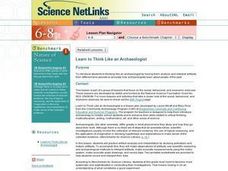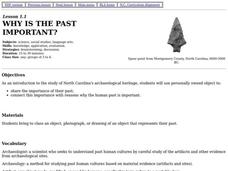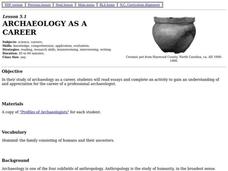Curated OER
Archaeological Finds
Students demonstrate the goals and methods of archaeology and write a report of an archaeological dig at a site associated with a specific culture. They explore the science of archaeology and how it contributes to the understanding of...
Curated OER
Archaeology of Utah
Fourth graders investigate the significance of rock art and archaeology of Utah. They listen to the books "Before You Came This Way" and "When Clay Sings," and write a story and create an illustration about rock art.
Curated OER
Leaarn to Think Like an Archaeologist
Students examine how to act as archaeologists by examining artifacts. The inquiry is meant to teach learners about analysis of ancient civilizations and scientific finds. Fossil evidence is also covered to make connection to the...
Curated OER
The Archaeology of Cactus Ruin
Students simulate archaeologists by excavating a paper site. In groups, they use a sampling strategy to determine information about the people who lived at the site.
Curated OER
Becoming a Louisiana Archaeologist
Pupils examine pieces of pottery as they role play archaeologists. They use cutouts and examine them for markings. They complete a worksheet to end the lesson plan.
Curated OER
Ethics in Archeology
Middle schoolers discuss their views about archeological site protection. They analyze different dilemmas dealing with this issue and discuss. They discover the importance of protecting artifacts and archeological sites.
Curated OER
The Pottery Project
Middle schoolers research Native American culture regions and archaeology techniques. In small groups, they decorate a clay pot, break the pots, and repair and analyze the designs on the pottery.
Curated OER
Visit a Mesopotamian House
Students compare the homes of people who lived in ancient Mesopotamia to their own and explore how climate, natural resources, and cultural differences may have influenced the differences. The house plan can be obtained from the wed site.
Curated OER
Dig This
Fifth graders explore the work of paleontologists and the life of dinosaurs and create a sculpture of the bones of a Stegosaurus. The sculpture was then buried and used by other classes for a dig.
Curated OER
Why is the Past Important?
Fourth graders discuss the importance of North Carolina's archaeological heritage. They share with the class an object, photograph, or drawing of an object that represents their own or their family's past.
Curated OER
Take Action, Save the Past
Eighth graders use their creative and critical thinking skills to find useful solutions to current and future problems concerning the destruction of archaeological sites and artifacts.
Curated OER
Archaeology as a Career
Fourth graders read about archaeology as a career. They develop a list of questions they would like to ask an archaeologist and then actually interview an archaeologist on the future of archaeology as a career.
Curated OER
Stratigraphy and Cross-Dating
Students interpret archaeological strata using the law of superposition. They apply cross-dating to determine the age of other artifacts.
Curated OER
Clues to the Past
Pupils analyze how arhaeologists study the past. They define basic archaeological terms, make general inferences from observations, and explain the importance of context.
Curated OER
Why Archaeologists Dig Square Holes
Students examine how archaeologists establish and maintain the context of artifacts. They interpret a plan view of an archaeological site and explain the importance of the grid system.
Curated OER
Pottery Analysis
Students study how archaeologists analyze artifacts to answer questions about past cultures. They explain why pottery is important to archaeologists and how they use classification to answer their research questions.
Curated OER
Lesson 4: A Field Trip to the Maine State Museum
Students analyze the Maine State Museum's exhibit 12,000 Years in Maine. They create an artifact and write a description of that artifact that demonstrates their understanding of the way technology shapes culture.
Curated OER
"it's All in the Cellar"
Seventh graders examine the process of constructing a site plan map at archaeological sites. They discuss the process of mapping techniques and calculation of percentages, create a plan site map of a cellar at Jamestown, and calculate...
Curated OER
"How to Think Like an Archaeologist" - Suggested Pre-Visit Activity For Historic Jamestown
Pupils examine how archaeologists use artifacts to explore other people and their cultures. They discuss types of artifacts, analyze receipts for clues, and discuss how what the items bought reflect about people.
Curated OER
Working With Animals
Second graders study careers that involve animal care such as veterinarians, zookeepers and archeologists. They create a collage of animal drawings related to the careers.
Curated OER
Discovering the Past Using the Future: Remote Sensing and the Lost City of Ubar
Young scholars use a video, maps, worksheets and Internet research to explore the role that sensing played in locating Ubar - the lost city of Arabia.
Curated OER
Our Link To The Past
Learners explore how we are linked to the past and what that means. Inquires are made into the concept of history as the passage of time and changing seasons.
Curated OER
Kincaid Shelter Stratigraphy
Seventh graders illustrate how archeologists use stratigraphy to help determine environmental changes in a specific area since the Pleistocene Era, and to point out that these changes have affected the animals living in that area.
Curated OER
Utah Archaeology
Students use Play-dough explore different types of fossils and examine how fossils are evidences of past life.

























